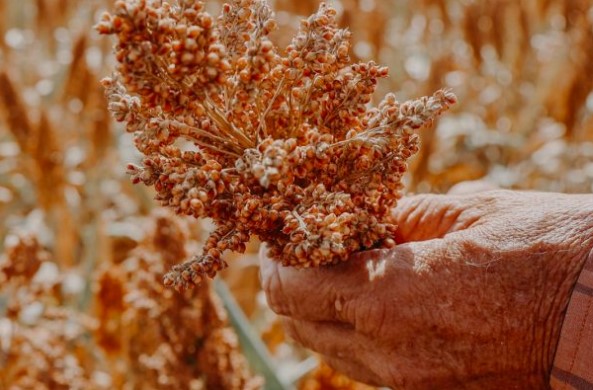
Agricultural News
Milo Or Sorghum What Say You?
Thu, 18 Nov 2021 08:01:19 CST
 The Fall 2021 edition of Sorghum Grower magazine is now available online! This issue is focused on discovering some truths about sorghum and gaining some historical perspective on some of the terms and technologies we use today.
The Fall 2021 edition of Sorghum Grower magazine is now available online! This issue is focused on discovering some truths about sorghum and gaining some historical perspective on some of the terms and technologies we use today.
Here is one of the featured articles in this season's magazine, by Peter Hill, originally posted to "The Refined Woodworking Agronomist" blog May 2021:
I was recently asked by David Ocker, "Where did the nickname for sorghum, 'milo,' originate?"
There are several sources that can enlighten us on the history of sorghum and its relatives and many theories on the various names we call it today.
I thought this excerpt taken from the book, Crop Pro-duction - Evolution, History and Technology by C. Wayne Smith (Wiley & Sons, Inc., 1995), provided valuable insight on how various sorghum types, including milo, came into production in the United States.
"Deliberate introduction of sorghum began in 1857 with the importation of a 'sorgo' type used for the production of syrup. These are referred to today as cane sorghum, sweet sorghum or cane, not to be confused with sugar cane. In that year, seed of Chinese Sugarcane, a sorgo or syrup sorghum, was sent to Texas by the U.S. Indian Service for production in the Brazos and Comanche Amerindianism reservations. Additional early introductions were:
1874: Brown and white seeded durras called "gyp" corn, as they were falsely believed to have originated in Egypt.
1876: Kafir type from South Africa.
1880: Milo, milo maize, or giant milo: race and origin unknown.
1890: Shallu, a guinea-kafir intermediate from India.
1906-8: Feterita, race caudatum, or intermediate race durra-caudatum, from Sudan.
1906-8: Hegari type, race dauatum, from Sudan; and
1906-8: Pink kafir from South Africa.
All of the early sorghums were for forage or were dual-purpose - i.e., they were grazed, baled, and/or seed harvested as feed. Early farmers in the more arid plains of Oklahoma and Texas quickly realized the difficulty and uncertainty of producing corn as a feed for work animals and turned to the more drought-tolerant grain sorghum. The Texas Agricultural Experiment Station Bulletin No.
13 published in 1890 reported 23 varieties (i.e., cultivars) of sorghum available to Texas producers. That publication noted that farmers valued both the stalk and grain as feed stuffs. The need for more drought-tolerant crops in the arid plain states resulted in the majority of early plant improvement in grain sorghum being accomplished in Texas, Oklahoma, and Kansas.
The early sorghums in the United States were tall-growing and late-maturing, facts that we will return to subsequently. But the milo maize introduction of 1880, later referred to as Giant Milo, spread to Texas by 1890 and was particularly tall growing. In fact, the common Texas folk tale of this sorghum was that it took a ladder to reach the head, an axe to cut the stalk, and a grubbing hoe to uproot the stubble. Seed of tall sorghums of that time were harvested by a person standing on a mule-pulled wagon to cut off heads and then of course accumulate the heads in the wagon for transport.
Shortly after the turn of the century, farmers found early maturing heads of Giant Milo, which gave rise to a cultivar called Standard Milo. (Note that much of the literature will use the term 'milo' to refer to grain sorghum of the durra race. Much of this race is characterized by a recurved peduncle such that the head is upside down at maturity.) Also about 1900, a farmer in Oklahoma selected Dwarf Yellow Milo from Standard Milo, seed of which were purchased by A B. Conner for the U.S. Department of Agriculture (USDA) and distributed to farmers in north Texas near the town of Chillicothe.
The distribution probably occurred between 1905 and 1910, as the Texas Agricultural Experiment Station and the USDA began research efforts at Chillicothe in 1905. An earlier-maturing cultivar, Early White Milo, was selected from the yellow milos about 1910."
So, did this excerpt really answer the question on where the name "milo" came from? I think given that milo was a type of sorghum introduced and cultivated throughout the United States since 1880, it stands to reason the name carried over through the generations. At least in my travels throughout the south and Great Plains regions, milo and sorghum are used inter-changeably. And given that a high percentage of it is for grain production, I understand both to mean the same. Perhaps other regions of North America call it something different?
In today's world of grain production, varieties of sorghum other than the standard grain sorghums sold by the major seed companies are generally grown and sold by heirloom seed providers. Scouring the web, it's easy to find providers of kafir, sweet sorghum and other old-world varieties. You'll often find old cane presses being demonstrated at country fairs and antique farming shows.
If the reader is curious about the etymological origin of milo, look no further. The answer to that question lies in the online American Heritage Dictionary.
WebReadyTM Powered by WireReady® NSI
Top Agricultural News
More Headlines...




